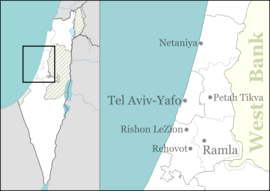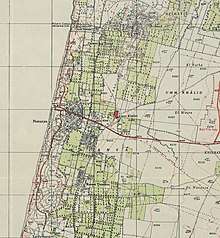Avihayil
Avihayil (Hebrew: אֲבִיחַיִל, lit. Father of strength) is a moshav in central Israel. Located to the north-east of Netanya, it falls under the jurisdiction of Hefer Valley Regional Council. In 2018 it had a population of 1,410.[1]
Avihayil אֲבִיחַיִל | |
|---|---|
 Avihayil  Avihayil | |
| Coordinates: 32°21′1.44″N 34°52′19.56″E | |
| Country | |
| District | Central |
| Council | Hefer Valley |
| Affiliation | Moshavim Movement |
| Founded | July 19, 1932 |
| Founded by | Jewish Legion veterans |
| Population (2018)[1] | 1,410 |
History
In 1921, Jewish veterans of the British Army during World War I settled on desert land allocated to it by the British Mandate government in the northeastern Negev, near Tel Arad. However, the settlement was abandoned after no water was found.
As part of the Settlement of the Thousand scheme, a new village was founded in the Emek Hefer on 19 July 1932 on a stretch of sand dunes on land owned by the Jewish National Fund. The founders were veterans of the Zion Mule Corps and the Jewish Legion, battalions of the British Army that had fought under the command of Lieutenant-Colonel John Henry Patterson, a vocal Zionist advocate and the "godfather of the Israeli army". Colonel Patterson visited the moshav in 1937, and in his last years expressed his desire to be buried in Israel with his men.[2]
In 1946 Avihayil merged with the neighboring moshav, Ein HaOved. The founders were immigrants from Canada, Russia and the United States, as well as several native Israelis. In 1947, Avihayil had a population of 600.[3] In 1967 there were 605 inhabitants, and its economy was based on intensive mixed farming including citrus. It established "Beit HaGedudim", a museum of the Jewish Legion and clubhouse for veterans.
Colonel Patterson died in California in 1947, less than a year before the establishment of the State of Israel, and was interred at Angelus-Rosedale Cemetery in Los Angeles. In 2014, Patterson's ashes were brought to Israel and buried at the moshav cemetery, in the presence of Prime Minister Benjamin Netanyahu and other dignitaries.[2]


References
- "Population in the Localities 2018" (XLS). Israel Central Bureau of Statistics. 25 August 2019. Retrieved 26 August 2019.
- Remains of ‘godfather of Israeli army’ buried in Israel
- Jewish National Fund (1949). Jewish Villages in Israel. Jerusalem: Hamadpis Liphshitz Press. p. 7.
| Wikimedia Commons has media related to Avihayil. |